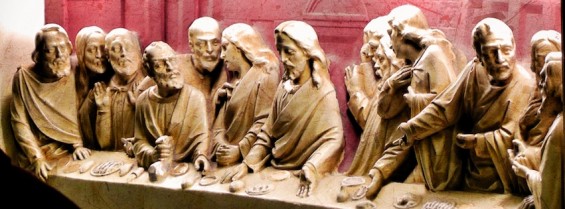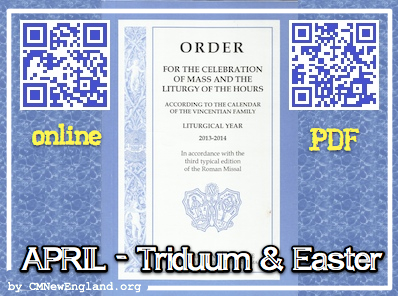 Liturgical norms for Holy Thursday evening celebrations according to ORDO – Liturgical calendar for the Vincentian Family.
Liturgical norms for Holy Thursday evening celebrations according to ORDO – Liturgical calendar for the Vincentian Family.
MASS OF THE LORD’S SUPPER,
with proper formularies, Gloria,
with proper Preface and proper inserts for the Eucharistic Prayer.
liturgical color: white
R1 Ex 12,1-8. 11-14; Ps 115,12-13. 15-16bc. 17-18.
R2 1 Cor 11, 23-26,
Go Jn 13,1-15,
1. With this Mass, celebrated on the evening of Holy Thursday, the Church inaugurates the sacred Paschal Triduum, aimed at recalling that Last Supper, when the Lord Jesus, on the night he was betrayed, loving those who were his own in the world until the very end, offered his Body and Blood under the species of bread and wine to God and under these symbols, gave them to his Apostles that they might consume them, and commanded them and their successors in the priesthood to offer them.
By means especially of the homily, attention should be focused upon the mysteries which are commemorated in this Mass, namely the institution of the Eucharist and that of the priestly Order, together with the Lord’s command of brotherly love.
2. The Mass of the Lord’s Supper is to be celebrated in the evening, at the most appropriate hour, with the full participation of the whole local community.
Priests who have already concelebrated at the Chrism Mass, or who are obliged to celebrate another Mass for the faithful, may also concelebrate at the Mass of the Lord’s Supper.
In accordance with a most ancient tradition of the Church, the celebration of Mass without a congregation is prohibited today.
3. Where pastoral reasons urge it, the local Ordinary may permit another Mass to be celebrated in churches and chapels in the evening and even, in case of real need, in the morning, but in this latter case only for the sake of those faithful who cannot in any way take part at the evening Mass. Care should be taken lest any celebration of this kind be undertaken for the advantage of private individuals and lest it prejudice the evening Mass.
4. The Tabernacle should be empty. Hosts should be consecrated at this Mass for the communion of clergy and people today and tomorrow.
5. It is fitting that for the reservation of the Eucharist to serve for communion tomorrow, a chapel should be arranged in which prayer and meditation may be fostered, but it is also highly recommended that all be marked by that austerity which is appropriate to these days.
If the Blessed Sacrament is normally reserved in a chapel separate from the central nave of the church, the place of reposition and of adoration may suitably be set up there.
The Blessed Sacrament should be reserved, however, in a closed tabernacle, exposition in a monstrance being absolutely excluded. Nor should the tabernacle in any way have the appearance of a tomb, and the term ‘tomb’ or ‘sepulchre’ should be avoided, since the chapel of reservation is not intended to represent the Lord’s tomb, but only to reserve the Blessed Sacrament for communion the next day.
6. While the Gloria (Glory to God in the highest…) is being sung, the bells are rung. From the end of this hymn the bells are then silent until the Easter Vigil, unless the Bishops’ Conference or the Bishop of the diocese for appropriate reasons decide otherwise.
7. The washing of feet, which according to the tradition for this day is done for a select number of men, shows forth the service and the love of Christ, who came not to be served but to serve. It is appropriate that this tradition be maintained and its true meaning be explained.
8. In the procession bearing the gifts it is fitting that there be included gifts destined for the poor, especially gifts which have been collected during Lent as the fruits of penance. While this happens the hymn Ubi‚ caritas (Where charity and love…) is sung.
9. At the end of the prayer after communion, omitting the other concluding rites, a procession is formed which makes its way through the church with incense and candles, bearing die Eucharist to the chapel of reservation.
10. After the end of today’s celebration, the altar is privately stripped and if possible all crosses are removed from the church. It is appropriate that any crosses remaining in the church be Veiled, if they
have not already been veiled by decision of the Bishops’ Conference (cf. p. 85).
11. The faithful should be reminded to spend a suitable length of time during the night, according to circumstances of time and place, in adoration before the Blessed Sacrament reserved, in such a way, however, that after midnight the adoration take place without solemnity.
12. The procession and the reposition of the Blessed Sacrament should not take place in churches where it is not intended to celebrate the solemn Liturgy of the Lord’s Passion on Good Friday.
LITURGY OF THE HOURS
VESPERS are not recited by those who take part in the evening Mass.
(liturgical color: purple)
COMPLINE as after Second Vespers of Sunday.
Good Friday of the Passion of the Lord is a day of penance for the whole Church, to be marked by fasting and abstinence from meat (cf. p. 27)
For more information visit this page:
ORDO – Liturgical Calendar of the Vincentian Family
or scan one of the codes in the image

Leave a Reply